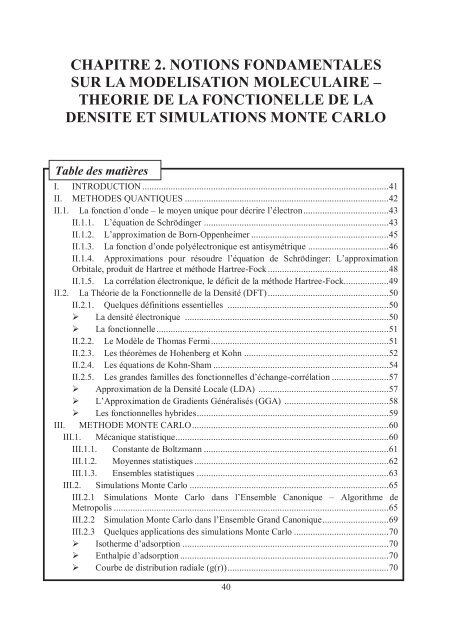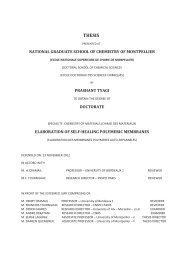Zalfa NOUR Modélisation de l'adsorption des molécules à fort ...
Zalfa NOUR Modélisation de l'adsorption des molécules à fort ...
Zalfa NOUR Modélisation de l'adsorption des molécules à fort ...
You also want an ePaper? Increase the reach of your titles
YUMPU automatically turns print PDFs into web optimized ePapers that Google loves.
CHAPITRE 2. NOTIONS FONDAMENTALESSUR LA MODELISATION MOLECULAIRE –THEORIE DE LA FONCTIONELLE DE LADENSITE ET SIMULATIONS MONTE CARLOTable <strong>de</strong>s matières_Toc286477026I. INTRODUCTION ........................................................................................................ 41II. METHODES QUANTIQUES ...................................................................................... 42II.1. La fonction d’on<strong>de</strong> – le moyen unique pour décrire l’électron .................................... 43II.1.1. L’équation <strong>de</strong> Schrödinger .............................................................................. 43II.1.2. L’approximation <strong>de</strong> Born-Oppenheimer .......................................................... 45II.1.3. La fonction d’on<strong>de</strong> polyélectronique est antisymétrique .................................. 46II.1.4. Approximations pour résoudre l’équation <strong>de</strong> Schrödinger: L’approximationOrbitale, produit <strong>de</strong> Hartree et métho<strong>de</strong> Hartree-Fock ................................................... 48II.1.5. La corrélation électronique, le déficit <strong>de</strong> la métho<strong>de</strong> Hartree-Fock ................... 49II.2. La Théorie <strong>de</strong> la Fonctionnelle <strong>de</strong> la Densité (DFT) ................................................... 50II.2.1. Quelques définitions essentielles .................................................................... 50 La <strong>de</strong>nsité électronique ...................................................................................... 50 La fonctionnelle .................................................................................................. 51II.2.2. Le Modèle <strong>de</strong> Thomas Fermi ........................................................................... 51II.2.3. Les théorèmes <strong>de</strong> Hohenberg et Kohn ............................................................. 52II.2.4. Les équations <strong>de</strong> Kohn-Sham .......................................................................... 54II.2.5. Les gran<strong>de</strong>s familles <strong>de</strong>s fonctionnelles d’échange-corrélation ........................ 57 Approximation <strong>de</strong> la Densité Locale (LDA) ....................................................... 57 L’Approximation <strong>de</strong> Gradients Généralisés (GGA) ............................................ 58 Les fonctionnelles hybri<strong>de</strong>s ................................................................................. 59III. METHODE MONTE CARLO ................................................................................... 60III.1. Mécanique statistique .......................................................................................... 60III.1.1. Constante <strong>de</strong> Boltzmann .............................................................................. 61III.1.2. Moyennes statistiques .................................................................................. 62III.1.3. Ensembles statistiques ................................................................................. 63III.2. Simulations Monte Carlo .................................................................................... 65III.2.1 Simulations Monte Carlo dans l’Ensemble Canonique – Algorithme <strong>de</strong>Metropolis .................................................................................................................... 65III.2.2 Simulation Monte Carlo dans l’Ensemble Grand Canonique ............................ 69III.2.3 Quelques applications <strong>de</strong>s simulations Monte Carlo ........................................ 70 Isotherme d’adsorption ....................................................................................... 70 Enthalpie d’adsorption ........................................................................................ 70 Courbe <strong>de</strong> distribution radiale (g(r)).................................................................... 7040











